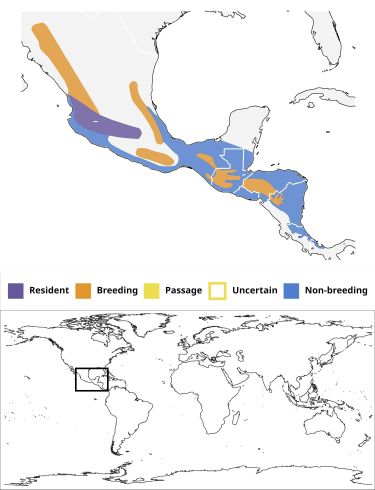m |
|||
| Line 15: | Line 15: | ||
==Taxonomy== | ==Taxonomy== | ||
| + | ====Subspecies==== | ||
| + | Clements regards this as a [[Dictionary_M-O#M|monotypic]] species [[#References|[1]]]. | ||
==Habitat== | ==Habitat== | ||
Marshy areas, often surrounded by sugarcane fields. Observed at heights around 762 m. | Marshy areas, often surrounded by sugarcane fields. Observed at heights around 762 m. | ||
| Line 26: | Line 28: | ||
</gallery> | </gallery> | ||
==References== | ==References== | ||
| − | #BF Member observations | + | # {{Ref-Clements6thOct22}}#BF Member observations |
==External Links== | ==External Links== | ||
{{GSearch|Empidonax+albigularis}} | {{GSearch|Empidonax+albigularis}} | ||
Latest revision as of 12:47, 12 October 2023
| This article is incomplete. This article is missing one or more sections. You can help the BirdForum Opus by expanding it. |
- Empidonax albigularis
Identification
Similar species
Likely to overlap with Acadian Flycatcher, Alder Flycatcher, Black-capped Flycatcher, Buff-breasted Flycatcher, Cordilleran Flycatcher, Dusky Flycatcher, Gray Flycatcher, Hammond's Flycatcher, Least Flycatcher, Pacific-slope Flycatcher, Pine Flycatcher, Willow Flycatcher, Yellow-bellied Flycatcher, Yellowish Flycatcher.
See also Empidonax.
Distribution
Belize, Costa Rica, El Salvador, Guatemala, Honduras, Mexico, Nicaragua, and Panama.
Taxonomy
Subspecies
Clements regards this as a monotypic species [1].
Habitat
Marshy areas, often surrounded by sugarcane fields. Observed at heights around 762 m.
Behaviour
Gallery
Click on photo for larger image
Adult
Photo by Peter R. Bono
San Cristobal des las Casas, Chiapas, Mexico, July 2009Adult
Photo by Peter R. Bono
San Cristobal des las Casas, Chiapas, Mexico, July 2009]]
References
- Clements, J. F., T. S. Schulenberg, M. J. Iliff, T. A. Fredericks, J. A. Gerbracht, D. Lepage, S. M. Billerman, B. L. Sullivan, and C. L. Wood. 2022. The eBird/Clements checklist of Birds of the World: v2022. Downloaded from https://www.birds.cornell.edu/clementschecklist/download/
- BF Member observations







